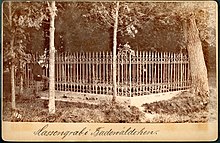Mass grave
A mass grave is a grave in which several to many dead are usually buried anonymously . Mass graves are laid on various occasions. In contrast to collective graves , the ones lying there are mostly buried without a precise assignment of the location in the burial site and without considering the individual dignity of the deceased.
Historical
Mass graves are already known from the era of the linear ceramic culture around 7000 years ago. a. as a result of the Talheim massacre , the Kilianstädten massacre and the Schletz massacre .
Occasions
Fallen and war dead

The soldiers and civilians killed as a result of a battle were and are mostly buried in mass graves. The burial is often done by local civilians. In the bombed cities of World War II, the victims of the bombing war were buried both individually and in mass graves.
Victims of mass murders
After mass murders in totalitarian regimes, the victims are buried in mass graves. One example are the mass graves in Butowo south of Moscow, a place of execution during the period of the "Great Purge" (1936–1938) in the Soviet Union.
Mass graves are also laid in the event of massacres in wars and civil wars , and sometimes those to be executed have to dig the graves themselves. These war crimes are often only proven years later by statements from those who have escaped or by the accidental discovery of the mass grave for the world public and possibly documented conclusively for court proceedings. The civilian murder victims from the Spanish Civil War buried in mass graves have only recently been dealt with in a large number of books on the subject of contemporary history. In Germany, the first Wehrmacht exhibition (1995–1999) on the crimes of the Wehrmacht , which ran through many cities, led to a broad discussion of the innumerable massacres in World War II, even outside the specialist community. In the occupied countries of Greece, France ( Oradour ) and Italy , among others, the Wehrmacht had executed the population of entire villages as part of acts of revenge and buried the victims in mass graves.
Similar horrors have become known in contemporary history in Rwanda , the Congo and Sudan . One example from Europe is the so-called “ethnic cleansing” in Bosnia , for example in Srebrenica .
Natural disasters

After natural disasters , mass graves are often dug in order to avert an alleged risk of epidemics through quick burial. Experts assume that such dangers generally do not exist. The World Health Organization has stated in a handbook: "Corpses do not lead to epidemics after natural disasters." The Pan American Health Organization (PAHO) assumes that, with good planning, one can dispense with a large part of the anonymous mass burials in favor of more individual forms.
Burial of poor people
Since the burial of a person in a cemetery is connected with material and labor, the deceased were and are buried in mass graves without sufficient funds.
See also
literature
- Detlef Korte : Education in the mass grave. The history of the Nordmark Kiel Russee labor education camp 1944–1945. Neuer Malik-Verlag, Kiel 1991. 391 pages, ISBN 3-89029-922-9 .
Web links
Individual evidence
- ↑ Christoph Drösser: Leichengift in: Die Zeit , April 26, 2007.
- ^ Pan American Health Organization: Management of Dead Bodies in Disaster Situations ( Memento from December 30, 2004 in the Internet Archive ) (English).
